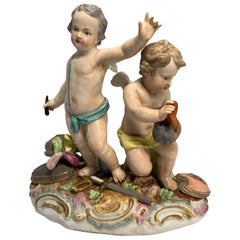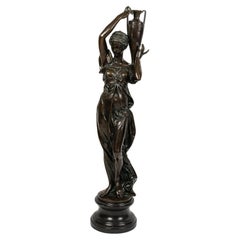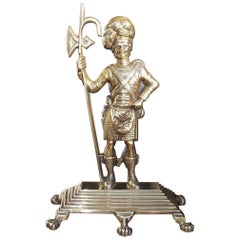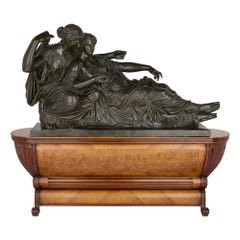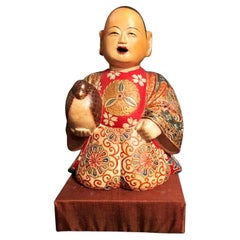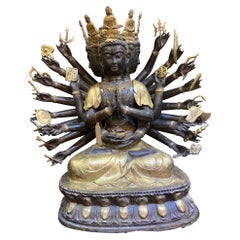19th Century Figurative Sculptures
to
409
3,739
1,146
3,739
9,115
2,774
2,285
3,223
2,050
304
156
564
568
253
497
569
674
388
268
275
224
148
139
79
77
36
30
29
19
13
12
7
6
4
2
1
1
2,044
1,702
1,002
829
665
1,872
1,594
3,061
1,593
713
250
247
Height
to
Width
to
3,739
3,739
3,739
73
29
27
26
19
Period: 19th Century
Royal Porcelain or State’s Porcelain Manufactory 'KPM' Cherub’s Sculpture
Located in Guaynabo, PR
This rare porcelain group sculpture depicts a pair of winged warriors cherub figurines. They are without their helmet, armor, and swords. One is in a victorious posture and the other...
Category
German Rococo Antique 19th Century Figurative Sculptures
Materials
Porcelain
$600 Sale Price
20% Off
Large Bronze Sculpture by A.CARBIER from the 19th Century.
Located in Saint-Ouen, FR
Large bronze sculpture by A.CARBIER from the 19th Century.
Elegant sculpture by A.CARBIER in patinated bronze from the 19th century, Napoleon III period, signed A.CARBIER, stamped i...
Category
French Napoleon III Antique 19th Century Figurative Sculptures
Materials
Marble, Bronze
Scottish Brass Highlander Royalty Guard Doorstop, Circa 1840
Located in Charleston, SC
Scottish brass Highlander Royalty Guard doorstop dressed in full military attire standing on a step back rectangular base with lions paw feet, Mid-19th ...
Category
Scottish George IV Antique 19th Century Figurative Sculptures
Materials
Brass
Antique French Sculpture Patinated Bronze Two Fates Barbedienne Lequesne
Located in London, GB
Antique French Sculpture Patinated Bronze Two Fates Barbedienne LequesneFrench, Late 19th Century
Sculpture: Height 81cm, width 143cm, depth 43cm
Base: Height 60cm, width 163cm, dep...
Category
French Antique 19th Century Figurative Sculptures
Materials
Bronze
Japanese Edo Period Saga Ningyo, Ca. 1850
Located in New York, NY
Japanese Edo Period Saga Ningyo, Ca. 1850
DIMENSIONS
Height: 9.5 inches
Width: 6 inches
Depth: 5 inches
Category
Japanese Japonisme Antique 19th Century Figurative Sculptures
Materials
Wood
Antique Tibetan Praying Crowned Buddha
Located in Chicago, IL
Antique Tibetan Praying Crowned Buddha
This buddha sits in a seating lotus position a triangular base. His many hands fan out behind his back. Two hands...
Category
Tibetan Tibetan Antique 19th Century Figurative Sculptures
Materials
Metal
French Fireside Hunting Dog Statue A handsome piece made in patinated iron
Located in Godshill, Isle of Wight
French Fireside Hunting Dog Statue
A handsome piece made in patinated iron and standing on a plinth, the dog is fully 3 Dimensional and looks great from all sides
He is in very good...
Category
Art Nouveau Antique 19th Century Figurative Sculptures
Materials
Iron
Pair of Bronze Regency Figures on Neoclassical Bases
Located in Wormelow, Herefordshire
A dramatic pair of antique regency era bronze figures, depicting the Roman God Mars and Goddess Minerva, elevated by stepped black marble bases with neoclassical style columns to the...
Category
French Regency Antique 19th Century Figurative Sculptures
Materials
Marble, Metal, Bronze
Antique 19th Century Gilt French Bronze of Venus & Cupid after Carrier-Belleuse
Located in Philadelphia, PA
A wonderful bronze of a seated Venus and Cupid.
Modeled with a recumbent Venus attended by Cupid on an oval plinth in the manner of Albert-Ernest Carrier-Belleuse.
With finely...
Category
French Beaux Arts Antique 19th Century Figurative Sculptures
Materials
Bronze
19th Century Terracotta Portuguese Figures
Located in London, GB
19th century Terracotta Portuguese figures
We share what we love, and we love this pair of hand-crafted 19th Century terracotta Portuguese ...
Category
Portuguese Early Victorian Antique 19th Century Figurative Sculptures
Materials
Terracotta
Sculpture in Gilded Stucco, Biscuit and Cherry Marble, Napoleon III Period.
Located in Saint-Ouen, FR
Sculpture in gilded stucco, biscuit and cherry marble, Napoleon III period, 19th century.
Sculpture in gilded stucco representing an elegant woman, biscuit and cherry marble from th...
Category
French Napoleon III Antique 19th Century Figurative Sculptures
Materials
Marble
Pair of Bronze Plaquettes with Putti, Signed Clodion, French, 19th Century
Located in Miami Beach, FL
In the first plaquette the putti drink wine, eat grapes, make music and wrestle in a field with a round temple in the background. Signed CLODION
In the second plaquette, young sat...
Category
French Neoclassical Antique 19th Century Figurative Sculptures
Materials
Bronze
$960 Sale Price / set
56% Off
French 19th Century Terracotta Bust of Madame Récamier, After Jean-Antoine Houdo
Located in Los Angeles, CA
A fine French 19th century terracotta bust of "Madame Récamier (French, 1777-1849)" The coyly gazing downward beauty, holding a veil across her chest r...
Category
French Neoclassical Antique 19th Century Figurative Sculptures
Materials
Terracotta
Pair of Hand Carved Distinguished Gentlemen Sculptures
Located in Scottsdale, AZ
Delve into the realm of exquisite craftsmanship and timeless artistry with this remarkable pair of hand-carved distinguished gentlemen. Each bust, unique in its depiction, captures t...
Category
Antique 19th Century Figurative Sculptures
Materials
Wood
Large Carrara Marble Group of Virgin, Child and the Baptist Signed P. Romanelli
Located in London, GB
Large Carrara marble group of Virgin, Child and The Baptist signed P. Romanelli
Italian, 19th century
Measures: Figure: height, 170cm, width 70cm, depth 40cm
Base: height 93.5cm, width 59.5cm, depth 43cm
Executed in stunning Carrara marble, this exceptional sculpture is signed for the Florentine artist Pasquale Romanelli...
Category
Italian Neoclassical Antique 19th Century Figurative Sculptures
Materials
Marble, Carrara Marble
French bronze of three putti
Located in London, GB
A very fine antique French bronze of three putti playing. Although the bronze group is very much in the manner of Clodion, it is signed 'Musee de Sevres'. The bronze works well from ...
Category
French Antique 19th Century Figurative Sculptures
Materials
Bronze
Ruffony, The Oath, Signed Bronze Sculpture, Late 19th Early 20th Century
By Ruffony
Located in MARSEILLE, FR
The Oath: bronze sculpture with a brown patina, of a young man, sword in hand, taking an oath
The round base is titled and signed by the artist: Oscar Ruffony. Swiss sculptor, but a...
Category
French Napoleon III Antique 19th Century Figurative Sculptures
Materials
Bronze
Nomoli Stone Figure, Sierra Leone, Kissi, Tribal Art
Located in Bochum, NRW
A Kissi Nomoli carved stone figure, a male with his hands wrapped around his knees, on a base; from the Kissi people of Sierra Leone.
Greyish brown patina, snout-like mouth, large no...
Category
Sierra Leonean Tribal Antique 19th Century Figurative Sculptures
Materials
Soapstone
"Le Secret" Art Nouveau Bronze Sculpture by Pierre Felix Masseau
Located in Chicago, US
Fix-Masseau set up his workshop in Paris where he attracted the admiration of Rodin. The latter was unable to convince him to join his studio. The quality of his sculptures was notic...
Category
French Art Nouveau Antique 19th Century Figurative Sculptures
Materials
Bronze
Large Indonesian Hand Carved Singa Singa Tribal Carving from Sumatra
Located in Yonkers, NY
A large antique hand carved tribal 19th century sculpture from the Batak People, northern Sumatra, called a Singa Singa with painted accents. Attracting our eye with its charismatic presence, this large hand carved shield from the Indonesian island of Sumatra is one of the most iconic images of the Batak tradition. Called a Singa Singa, it was placed in the exterior corners of the traditional houses adorned with boat-shaped roofs, to disperse fear. Presenting a high forehead and angular traits, this Singa Singa sculpture is accented with faint traces of black for the eyes and a nicely distressed patina revealing its life spent outdoors. The back is flat with a small hole. Perfect to decorate any wall or perhaps to be mounted on a base depending on your needs, its riveting presence and delicate scrolling décor will make this Batak Singa...
Category
Indonesian Tribal Antique 19th Century Figurative Sculptures
Materials
Wood
Italian 19th Century White Carrara Marble of Venus De Milo
Located in West Palm Beach, FL
A stunning and large scale Italian 19th century white Carrara marble of Venus de Milo. She is wonderfully sculpted with striking proportions and attention to detail. Venus de Milo is an ancient Greek statue created between 130 and 100 BC and believed to depict Aphrodite, the Greek goddess of love and beauty. She is considered one of the most famous works of ancient Greek sculpture...
Category
Italian Antique 19th Century Figurative Sculptures
Materials
Marble
True Pair Of French 19th Century Rouge Griotte Marble And Bronze Statues
Located in West Palm Beach, FL
A lovely true pair of French 19th century Rouge Griotte marble and patinated Bronze cherub statues. Each charming statue is raised on a circular R...
Category
French Antique 19th Century Figurative Sculptures
Materials
Bronze, Ormolu
Italian Bronze Sculpture of Emanuele Filiberto, Duke of Savoia, Carlomarochetti
Located in Lymington, Hampshire
An Italian bronze equestrian sculpture of Emanuele Filiberto, Duke of Savoia, by Baron Carlo Marochetti, the duke wearing full arm...
Category
Italian Antique 19th Century Figurative Sculptures
Materials
Bronze
E Picault Gilt Bronze Statue Titled "Gratus Animus " or "Gratitiude"
Located in Vancouver, British Columbia
A beautifully cast late 19 century French bronze statue by Emile Picault of a classically draped winged maiden on clouds holding a tablet inscribed "La Reconnaissance est La Memoire ...
Category
French Romantic Antique 19th Century Figurative Sculptures
Materials
Marble, Bronze
'La Jeunesse' 19th Century bronze sculpture by Chapu and Barbedienne
Located in London, GB
This fine and exceptionally cast patinated bronze sculpture is the work of two masters of the decorative arts, Henri Chapu (French, 1833-1891) and Ferdinand Barbedienne (French, 1810-1892). Chapu was responsible for the design of the sculpture which is titled 'La Jeunesse' and depicts a young girl swathed in Classical style clothing reaching up to place a laurel branch on top of a wall.
The original work was crafted in white marble as part of a monument to Henri Regnault...
Category
French Neoclassical Antique 19th Century Figurative Sculptures
Materials
Bronze
Bronze Sculpture with Brown Patina, Signed Dorval, the Night, 19th Century.
Located in Saint-Ouen, FR
Bronze sculpture with brown patina, signed Dorval, the night, 19th century.
Sculpture by J.Dorval, the night, sculpture in bronze with brown patina, 19th century, Napoleon III perio...
Category
French Napoleon III Antique 19th Century Figurative Sculptures
Materials
Bronze
An articulated artist Dummy, Italy end of 19th century.
Located in Milan, IT
An articulated mannequin of a medium-sized painter, with the face to life. The mannequin is sculpted and made of fruit wood. The height-adjustable stand (40” – 55”, diameter 8”), is ...
Category
Italian Antique 19th Century Figurative Sculptures
Materials
Metal
Pair of Chinese Sancai Fu Lion Protectors, c. 1850
Located in Chicago, IL
Believed to be powerful protectors against malevolent spirits, fu lion dogs have stood guard at the entryways and thresholds of Chinese homes for centuries. This pair of small cerami...
Category
Chinese Qing Antique 19th Century Figurative Sculptures
Materials
Stoneware
19th Century Demosthenes Bronze Sculpture by Barbedienne Foundry
Located in 263-0031, JP
A bronze figure representing Demosthenes (384-322 BC), a Greek statesman and orator. The sculpture is based on a Roman copy of an original Greek statue. The chocolate-brown patina of...
Category
French Neoclassical Antique 19th Century Figurative Sculptures
Materials
Bronze
Pair of Egyptian Carved Ebonized Kneeling Figures
Located in Queens, NY
PAIR of Egyptian style (19/20th Cent) carved ebonized kneeling figures
Category
Unknown Egyptian Revival Antique 19th Century Figurative Sculptures
Materials
Ebony
Charming Italian 19th Century Carved Marble Group "Playful Putti with Goat"
Located in Los Angeles, CA
A very fine and charming Italian 19th century carved Carrara Marble Group "Playful Putti with Goat" depicting two young children, one riding the goat whose two front legs are in the ...
Category
Italian Rococo Antique 19th Century Figurative Sculptures
Materials
Carrara Marble
$29,850 Sale Price
39% Off
French 19th Century Louis XVI Style Ormolu Bust Signed Houdon and Frères
By Susse Freres
Located in West Palm Beach, FL
A striking French 19th century Louis XVI st. ormolu and patinated bronze bust of Diana the Huntress, signed Houdon and Susse Frères. The bust is raised by a striking circular base wi...
Category
French Louis XVI Antique 19th Century Figurative Sculptures
Materials
Bronze, Ormolu
John Willis-Good, (British, 1845 - 1879), ‘After The Race’
Located in Brighton, West Sussex
John Willis-Good (British, 1845 - 1879)
‘After The Race’.
A Silvered Bronze Equestrian Group Cast By Elkington & Co, Birmingham.
Depicting a racehorse with jockey up, at the dynam...
Category
English Antique 19th Century Figurative Sculptures
Materials
Slate, Bronze
Antique Bronze Putti on Marble Base styled after Albert-Ernest Carrier-Belleuse
Located in Chicago, IL
Antique Bronze Putti Sculpture on Marble Base styled after Albert-Ernest Carrier-Belleuse
Albert-Ernest Carrier-Belleuse (1824-1887) created the sculpture known as the, “Allegorie d...
Category
Unknown Baroque Revival Antique 19th Century Figurative Sculptures
Materials
Marble, Bronze
Bronze Sculpture of Satyr with Wineskin After an Antique Original, 19th Century
Located in Bagshot, GB
Bronze sculpture of Satyr with Wineskin in step position sitting upon a heavy marble base.
marble base is 30cm Deep and 31cm Wide.
Category
European Classical Greek Antique 19th Century Figurative Sculptures
Materials
Marble, Bronze
Pair Of European Carved Figures Of A Man And Woman
Located in Essex, MA
Featuring a man and woman in 19th century dress. Well carved .
Category
European Victorian Antique 19th Century Figurative Sculptures
Materials
Oak
Antique French Barbedienne Bronze Sculpture "Quand Même" by Antonin Mercié, 1884
Located in New Orleans, LA
Magnificent Antique French Bronze Sculpture, "Quand Même," Signed by French Sculptor Antonin Mercié (1845-1916) and Cast by Ferdinand Barbedienne (1810-1892...
Category
French Antique 19th Century Figurative Sculptures
Materials
Bronze
19th Century Highly Carved French Oak Sculpture of a Man Harvesting Wine Grapes
Located in Dallas, TX
This beautiful sculpture has been carved from solid French oak during the latter half of the 19th century. The style is that of Black Forest, with realistic depictions of branches, leaves, grapes, and more. Originally a French clock, most of the timing mechanisms have long been removed. The elaborate carving depicts a man harvesting wine grapes on rocky terrain dotted with vegetation. Our gatherer, who is clad in an overcoat and large brimmed hat, is carrying a hod (hotte in French) full of freshly picked grapes. A large wooden bucket...
Category
French Black Forest Antique 19th Century Figurative Sculptures
Materials
Wood
Fortunato Galli "Sea Nymph" White Marble Sculpture
Located in Astoria, NY
Fortunato Galli (Italian, 1850-1918) "Sea Nymph", White Marble Sculpture, late 19th century, signed "F. Galli"on a carved white marble pedestal. Sculpture: 64" H x 18" W x 16" D; ove...
Category
Italian Neoclassical Antique 19th Century Figurative Sculptures
Materials
Marble
$145,000 Sale Price
48% Off
Art Nouveau Stoneware Commedia Dell’arte Mask by Pierre-Adrien Dalpayrat
Located in Chicago, US
Exploring new firing and glazing techniques and their myriad effects on traditional forms was an exciting approach for many experimental turn-of-the-century ceramists. Here the acid ...
Category
French Art Nouveau Antique 19th Century Figurative Sculptures
Materials
Stoneware
Burmese Shan Ava Style Bronze Seated Buddha, 19th Century, Burma
Located in Austin, TX
A nice and classic Burmese Shan cast bronze Buddha in the Ava style, 19th century or earlier, Burma.
The Buddha sits upon a stepped and waisted stylized double lotus pedestal, le...
Category
Burmese Antique 19th Century Figurative Sculptures
Materials
Bronze
Italian Marble Statue Sculpture by Romanelli
Located in New York, NY
Finely carved Italian Carrara marble
Title: Amore E Psiche
Artist: Pasquale Romanelli (1812-1887)
Origin: Italian
Date: 19th century
Signature: Signed Prof. P. Romanelli/Fire...
Category
Italian Antique 19th Century Figurative Sculptures
Materials
Carrara Marble
French Bronze Sculptures from the 19th Century, Guèridon Statues
Located in Cesena, FC
French bronze sculptures from the 19th century - guèridon statues
(from the second half of the 1800s)
Two young girls in neoclassical clothing are depicted in the round: one holdin...
Category
French Antique 19th Century Figurative Sculptures
Materials
Bronze
Italian 19th Century Alabaster and Marble Statue
Located in West Palm Beach, FL
An elegant and decorative Italian 19th century alabaster and marble statue of a Greek goddess Ariadne seated on her panther. Gazing towards her left while her elbow rests on her pant...
Category
Italian Antique 19th Century Figurative Sculptures
Materials
Alabaster, Marble
An anatomical model, France circa 1860.
Located in Milan, IT
An anatomical plaster sculpture, depicting a flayed man seated on a cubic base, in a position with the torso tilted and the arms holding the head. Reference to a work of the French s...
Category
French Antique 19th Century Figurative Sculptures
Materials
Plaster
Japanese Kutani Statues Story of Momotaro Tsugata Yuma, 19/20th C
Located in Amsterdam, Noord Holland
Large, lovely and very nicely made Kutani statues
They depict the characters from the story of Momotaro (Peach Boy). Specifically, Momotaro himself, Do...
Category
Japanese Antique 19th Century Figurative Sculptures
Materials
Porcelain
$2,398 Sale Price / set
20% Off
Grand Tour Verdigris Marble After Giambologna, The Abduction of a Sabine Woman'
Located in West Palm Beach, FL
Grand Tour Verdigris Marble After Giambologna, The Abduction of a Sabine Woman'
Italy, Mid- 19th century, Attributed to the workshops of Benedetto Bosch...
Category
Italian Renaissance Antique 19th Century Figurative Sculptures
Materials
Marble
Figurine, Sanda ware, by Kinkodo Kisuke Edo period ceramic, celadon
Located in Autonomous City Buenos Aires, CABA
Figurine, Sanda ware, by Kinkodo Kisuke, Edo period, ceramic, celadon glaze
This ceramic piece depicts a seated man with a serene expression, dressed in a pale celadon green robe. Th...
Category
Japanese Edo Antique 19th Century Figurative Sculptures
Materials
Celadon
19th Century Animalier Bronze entitled "Chiens de Chasse" by Ferdinand Pautrot
Located in London, GB
An excellent late 19th Century French Animalier bronze group of a setter and pointer trying to flush out a pheasant with excellent rich brown patina and very fine hand chased surfac...
Category
French Art Nouveau Antique 19th Century Figurative Sculptures
Materials
Bronze
Large Antique Standing Bronze Buddha 24 Carat Gold Rattanakosin 63cm
Located in Poperinge, BE
Beautiful and rare authentic and antique bronze standing Buddha from Thailand from the Rattanakosin period, a large specimen gilded with 24 carat gold leaf, circa mid 19th century, t...
Category
Thai Antique 19th Century Figurative Sculptures
Materials
Bronze, Gold Leaf
Chinese Carved Root Deity Figure
Located in Queens, NY
Asian Chinese (19th Cent) carved root figure of a standing Deity
Category
Chinese Antique 19th Century Figurative Sculptures
Materials
Wood
Grand Tour sculpture of Narcissus, 19th c
Located in Stockholm, SE
This elegant 19th-century Grand Tour bronze sculpture represents Narcissus, the character from Greek mythology known for his beauty and self-admiration. Standing 65 cm high, the figu...
Category
Italian Antique 19th Century Figurative Sculptures
Materials
Bronze
Three Neoclassical Decorative Cabinet d Amateur Sculptures
Located in Miami, FL
Angelot: H 8 x W 8 x D 6
Oil Lampe : H 4.5 x W 9 x D 3
Portrait on a Bronze oval médaille : H 5 x W 5 x D 4
Category
Antique 19th Century Figurative Sculptures
Materials
Bronze
Italian "Bathing Venus" Patinated Bronze Sculpture
Located in Astoria, NY
Italian School, The Bathing Venus, Patinated Bronze Sculpture, late 19th century, cast by Fonderi Nelli Roma, the standing figure removing her elaborate robe on a circular base, stam...
Category
Italian Neoclassical Antique 19th Century Figurative Sculptures
Materials
Bronze
Bronze sculpture “Laurent de Medicis” after Michelangelo, 19th
By Michelangelo
Located in HÉRIC, FR
An important 19th-century bronze sculpture Michelangelo (1475-1564).
This Florentine sculptor, painter, architect, and poet is known for his monumental works such as the ceiling fres...
Category
French Antique 19th Century Figurative Sculptures
Materials
Bronze
Italian Glazed Terracotta Figural Bust of Diana, Goddess of the Moon, Circa 1850
Located in Charleston, SC
Italian glazed and hand-painted terracotta figural bust of Diana raised on a two tiered circular faux painted plinth. Goddess of the moon, Mid-19th Century.
Category
Italian Neoclassical Antique 19th Century Figurative Sculptures
Materials
Terracotta, Paint
Great Neapolitan Nativity Scene Ancient Architectural Capriccio '800
By Non-Standard Furniture and Lighting
Located in Milano, IT
On a round base is placed the nativity composed of the Holy Family with the ox and donkey, three cherubim fly to heaven. The seated Madonna and St. Joseph standing turn an adoring ga...
Category
Italian Other Antique 19th Century Figurative Sculptures
Materials
Terracotta, Silk, Wood, Cork
$4,719 Sale Price
20% Off
Georges Récipon, "Lucky", Gilt Patina Bronze Sculpture / Desk Paperweight
Located in Buenos Aires, Olivos
Georges Récipon, "Lucky", Gilt Patina Bronze Sculpture / Desk Paperweight. Signed and dated.
Beautiful bronze sculpture (gold patina) representing a naked woman nailed a horseshoe, ...
Category
French Art Nouveau Antique 19th Century Figurative Sculptures
Materials
Bronze
Sculpture clock depicting a native American, France 1890.
Located in Milan, IT
A clock with "Parisian" movement, with pendulum and half hour chime, white enamel dial with garlands of roses, inserted in a bronze patinated white (antimony) metal sculpture, with g...
Category
French Antique 19th Century Figurative Sculptures
Materials
Metal, Bronze
Pair 19th Century Solid Marble Louis XVI Pedestals ~ Columns
Located in Dallas, TX
PAIR 19th century solid marble Louis XVI Pedestals ~ Columns were designed to provide symmetry while displaying a particularly special work of art, sculpture, vase or other keepsake....
Category
French Neoclassical Revival Antique 19th Century Figurative Sculptures
Materials
Marble
Recently Viewed
View AllMore Ways To Browse
Fiberglass Mannequins
German Colonial
Glass Bonsai Tree
Guiraud Riviere
Jere Ship
Loie Fuller
Resin Skulls
Runners Bronze Sculpture
Zeus Europa
Ceramic Sculpture Torso
Chaim Gross Bronze
Crouching Male
Don Quixote And Sancho Panza
Elkington Bronze
Erik Hoglund Glass Sculpture
Eugene Delaplanche
Faux Marble Plinth
Female Mannequin Used Mannequins
